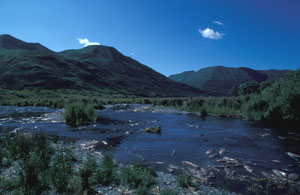|
A 7-9 Week Science Unit for Intermediate Level
Essential Questions:
- How are we connected to wetlands, rivers and the sea?
- What is the salmon’s life journey through the wetlands, rivers and the sea?
- Where does our local water come from and where does it go?
Enduring Understandings:
- Watersheds, rivers, wetlands, and the one big ocean of the world are an interconnected system.
- Salmon depend on the rivers and the ocean during parts of their life cycle.
- Science is a way to answer questions about the world around us.
Watershed investigations in this unit have been revised to align with NGSS Performance Expectations for Grade 3-5.
This unit is designed for 3rd grade, but could be adapted to other grades. Students develop knowledge of watersheds and the water cycle, as well as knowledge of the life cycle of salmon and the needs of salmon as they relate to watersheds. Activities include stories, discussion, a “crumpled-paper” watershed activity, a water cycle simulation game, collaborative research, and a field trip to a local water body to assess its potential to support salmon. Finally, students create and demonstrate a model of a healthy watershed. Language arts and art are incorporated into the unit, as are science notebooks.
Ocean Literacy Principles Addressed:
- The Earth has one big ocean with many features.
- The ocean is a major influence on weather and climate.
- The ocean supports a great diversity of life and ecosystems.
|
Investigation 1: Where Does My Water Come From? Where does our local water come from and where does it go? |
|
|
Investigation 2: Where Does Our Water Go? Students develop understanding of the water cycle through two separate activities. Activity 2A: Water Cycle Simulation How does water move through the water cycle? Activity 2B: Dirty Water/Clean Water Where does the water go after we have used it? |
|
|
Investigation 3: A Salmon’s Life Journey What is the salmon’s life journey through the wetlands, rivers, and the sea? |
|
|
Investigation 4: Fish Finders: Could Salmon Live Here? What do salmon need to survive during their various life stages? |
|
|
Investigation 5: Make Your Own Watershed What are the components of a watershed that can support salmon? |
Authors:
Tom McKenna, Teacher, Juneau, Alaska
Terry Slaven, Teacher, Wasilla, Alaska
Jennifer Wardes, Teacher, Kasilof, Alaska
Marilyn Sigman, Scientist, Center for Alaskan Coastal Studies, Homer, Alaska
Stephanie Hoag, Curriculum Consultant, Juneau, Alaska
Marla Brownlee, Alaska Sea Grant









